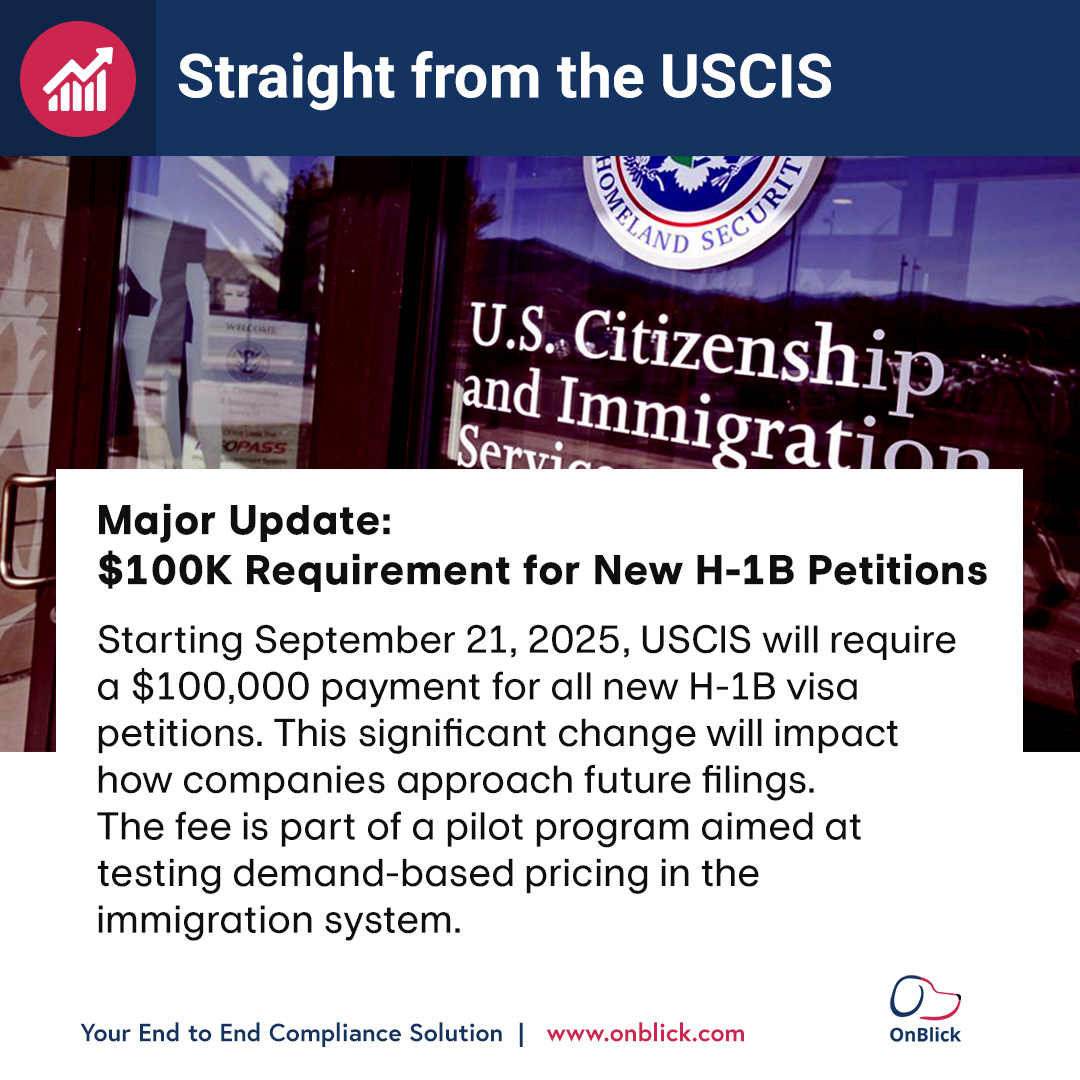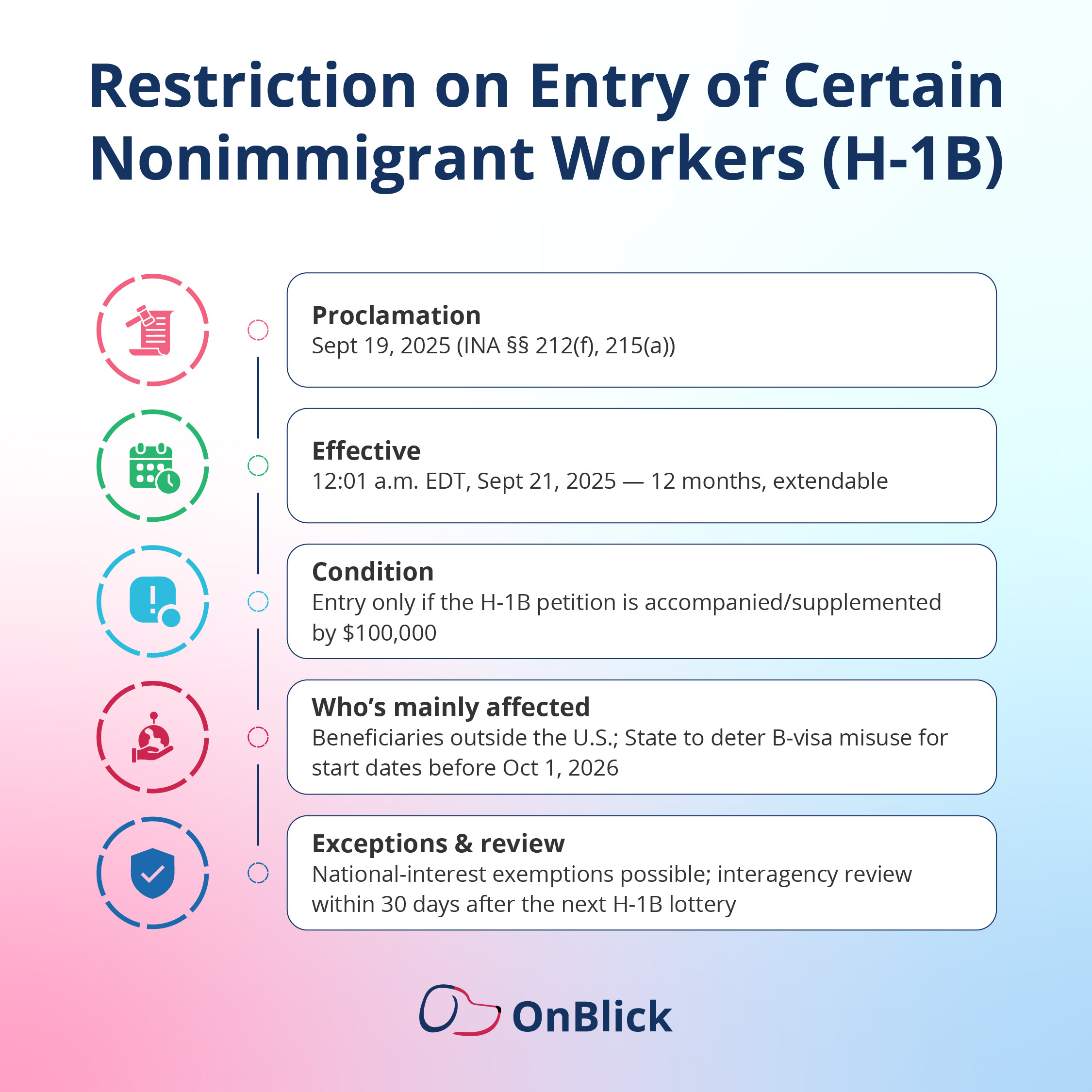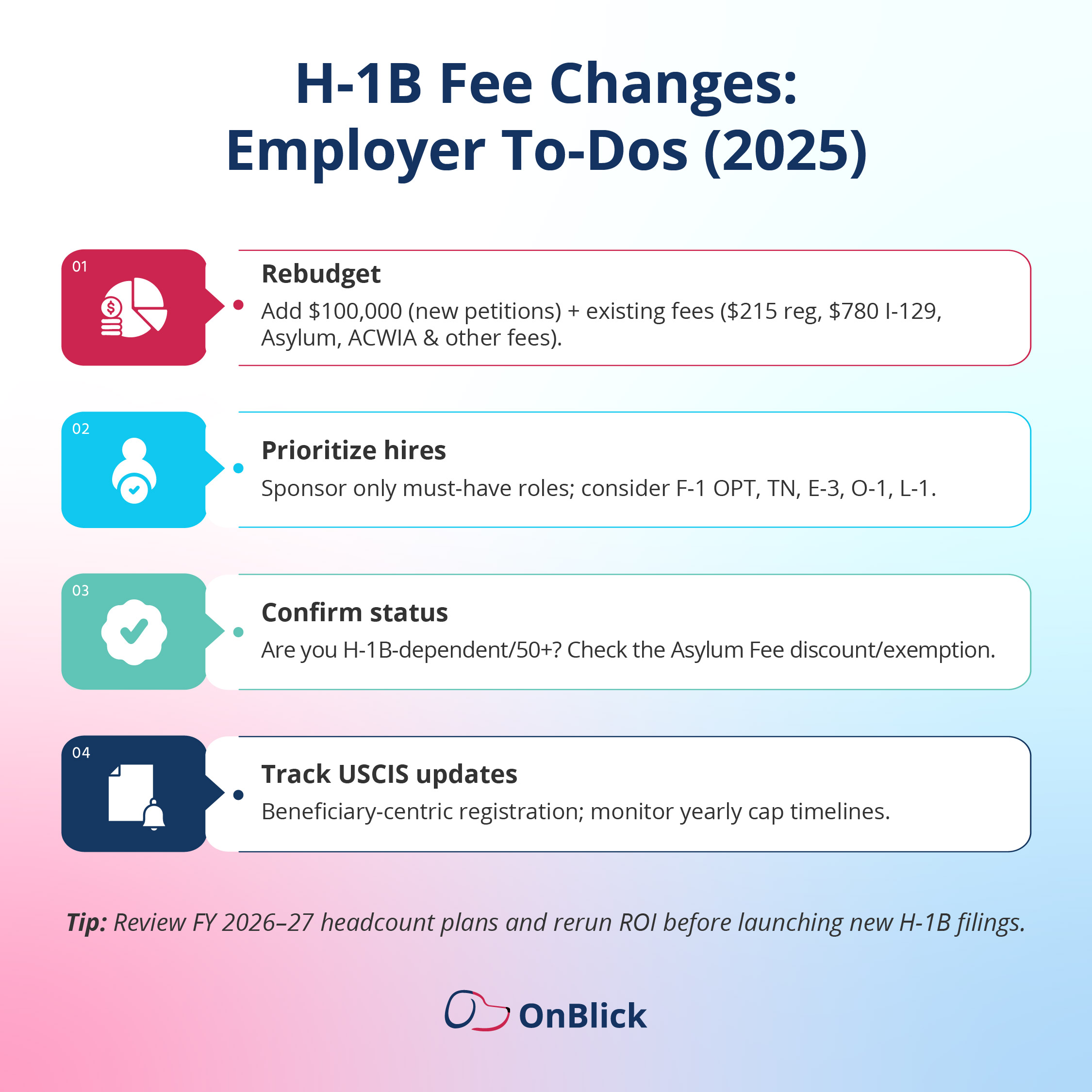Learn More

This guide summarizes the new $100,000 H‑1B supplemental payment attached to new petitions filed on/after 12:01 a.m. ET, Sept 21, 2025, clarifies who’s affected, and maps what employers should do next.
On Sept 19, 2025, the White House issued a proclamation “Restriction on Entry of Certain Nonimmigrant Workers” directing DHS/USCIS to restrict decisions on H‑1B petitions not accompanied by a $100,000 payment. USCIS’s H‑1B FAQ then clarified the effective instant (12:01 a.m. ET, Sept 21, 2025), that the payment applies to new petitions going forward, not to petitions filed before that time, not to renewals, and it does not prevent travel for current H‑1B visa holders. USCIS also released an implementation memo reinforcing the prospective scope.
What This Means Practically

In the immediate aftermath of the proclamation, early reporting and internal memos at major companies created a brief window of confusion, spawning conservative “do not travel” advisories and rapid‑fire updates to immigration FAQs. Search interest for h-1b visa news and h 1b visa news surged, while headlines echoed phrases like “USCIS announces fresh updates to h-1b visa rules”. Analysts framed the development within broader h-1b visa program changes, h1b visa rules update, and h-1b visa changes narratives to help employers understand scope and timing.
72-hour timeline
What this means for planning
With the initial dust settled, talent teams began mapping the impact to h-1b visa registration fy2026, tracking h-1b visa registration dates, and coordinating documentation for h-1b visa registrations 2026. Approvals mechanics remain familiar, but budgeting changes for h-1b visa approvals 2026. In parallel, strategy teams watch potential h-1b visa lottery changes, and the possibility of h-1b visa lottery registrations decline if prioritization rules materialize. Markets and industry bodies (e.g., NASSCOM) emphasized that the brunt falls on new hiring cycles and FY‑2026 plans.
Often summarized in headlines as trump h-1b, the policy narrative presents the supplemental payment as an initial and incremental reform intended to curb perceived abuses and protect American workers. The proclamation situates the change within broader h‑1b visa program changes and an h1b visa rules update, pointing to recent layoffs in heavy‑use sectors and high H‑1B utilization by certain employers as part of the justification.
In plain terms, the measure is framed as a market correction: raising the cost of new petitions (not renewals) to encourage higher‑wage, high‑skill filings. This logic dovetails with signals about potential h‑1b visa lottery changes and wage‑level prioritization - developments frequently grouped under h‑1b visa changes in media coverage and employer briefings.
Because the proclamation was initially discussed alongside entry policy, early reporting sometimes conflated it with h‑1b visa travel restrictions. Subsequent USCIS communications clarified that the supplemental payment attaches to new petitions, rather than travel for existing visa holders; nevertheless, employers adopted a cautious posture while guidance settled.

Beyond the immediate $100,000 supplemental payment on new filings, agencies have signaled additional levers that may shift the scenario in 2025–2026. In simple terms, think of this as a phased package of h-1b visa program changes aligned with an h1b visa rules update rather than a one‑off tweak.
What could change next (watchlist)
What employers should do now Budget for filings, model headcount scenarios under multiple lottery/wage assumptions, and track DHS/DOL/USCIS notices closely through FY‑2026. If leadership asks about the policy driver, situate it in the trump h-1b backdrop while noting that travel posture is governed separately under h-1b visa travel restrictions guidance.
USCIS confirms the new requirement is prospective, tied to when the petition is filed, and separate from standard USCIS fee schedules. It does not alter renewals. Anchor decisions in the USCIS FAQ and memo, and keep proof of timely filings to avoid misclassification.
Practically, treat this as a filing‑date trigger: any petition submitted on or after 12:01 a.m. ET, Sept 21, 2025, must include the supplemental payment. Align your immigration calendar with the FY‑2026 H‑1B registration window and the published registration dates and carry the same assumption through to 2026 approvals and budget forecasts. Keep contemporaneous evidence (delivery receipts, lockbox notices, courier tracking, and email confirmations) to demonstrate timely filing and avoid classification disputes.
Short answer: Expect a bigger budget line for each new H‑1B seat, tighter cash‑flow timing around filing, and constant policy monitoring. Here’s how that lands in practice - with numbers employers can use in planning.
Planning tip: Because USCIS is ~96% fee‑funded, fee changes and supplemental payments tend to be sticky across fiscal cycles. Treat the $100,000 as a hard budget input for new petitions until agencies say otherwise.

Expect the first large cohort exposed to the payment to be FY‑2026 cap filings. Build approvals and cash allocations ahead of time; assume status‑quo mechanics for registration and petition stages - with the new payment attached at petition filing. In practice, that means Finance, Legal, and Talent should lock a single intake calendar, define approval thresholds for each new H‑1B seat, and pre‑stage offer templates and candidate communications that explain the cost and timing. Cap‑exempt filings (universities, affiliated nonprofits) can proceed year‑round, but should still account for the supplemental payment on new petitions after the effective date.
USCIS will publish exact registration windows and mechanics; keep an eye on USCIS Alerts and All News pages, and secure internal legal/finance sign‑offs in advance. Historically, the electronic registration window opens for a short period in late winter/early spring, with selections communicated shortly afterward. Prepare by:
Coordinate headcount, eligibility, and documentation early; split candidate cohorts if cash timing matters. Track any agency notes that affect registrations to petitions sequencing for 2026. On the ground, that looks like:
Approval workflows (RFE timing, premium processing choices) may look familiar; the new piece is budgeting the supplemental payment for new cases submitted after Sept 21. Build an adjudication plan that:
Cap quick facts: The statutory caps remain 65,000 regular + 20,000 master’s each fiscal year; beneficiary‑centric registration reduces duplicates but does not change the cap. New petitions filed on or after Sept 21, 2025, must include the supplemental payment; renewals are unaffected.
Agency and legal analyses indicate the Administration could prioritize higher‑paid/higher‑skilled roles in the lottery, reshaping selection odds and employer strategy. Watch for DHS/DOL proposals and be ready to model outcomes by wage level.
If prioritization rules are adopted, lower‑wage‑level registrations could decline, changing portfolio strategy and possibly increasing the value of alternatives for some roles. (Monitor official notices for concrete data.)
The USCIS FAQ clarifies the payment is tied to new petitions, not to re‑entry for current H‑1B visa holders. DOS summarized the proclamation’s travel dimension; companies instituted temporary caution while guidance settled. For ongoing cases, align company travel posture with the latest USCIS/DOS guidance.
Several large firms urged H‑1B employees to avoid foreign travel or return to the U.S. before the effective time during the initial uncertainty window. Subsequent agency clarifications reduced the re‑entry risk for existing H‑1B visa holders, but many employers kept a conservative posture pending formal memos.
Tech Giants Warn H‑1B Visa Holders to Avoid Travel Abroad - Real‑Time Internal Memos
Media captured a flurry of internal comms across tech and finance (e.g., Amazon, Microsoft, JPMorgan, Meta) advising “stay put” or “return now” until USCIS/DOS clarifications were published. Use those 48‑hour memos as a case study in crisis comms and policy monitoring.
The new $100,000 supplemental payment on new H‑1B petitions changes more than budgets; it reshapes the timing and mix of workforce moves when demand softens. Startups and mid‑market firms feel the squeeze first: every new U.S. seat must now clear a higher business‑case bar, while large enterprises re‑prioritize roles that deliver outsized impact or regulatory value. For HR and Finance leaders, the practical question is how to protect delivery while controlling risk: tighten business cases, build redeployment lanes, and be ready with compliant wind‑down paths if reductions are unavoidable.
Operational Shifts You’ll Feel First
Compliance Essentials During Layoffs (Checklist)

Q1. Is the $100,000 payment annual?
No. It is a one-time supplemental payment that must accompany any new H-1B petition filed on or after 12:01 a.m. ET, Sept 21, 2025. It does not apply to petitions filed earlier in 2025, and it does not apply to extensions or renewals. Always confirm the latest USCIS FAQ and memo language before filing.
Q2. How long do I have to find a new role after H-1B termination?
Regulations provide an up to 60 day grace period in many cases. Timing starts at the earlier of the termination date or petition validity end. Use the window for internal transfer or new employer portability.
Q3. Can I transfer to an H-1B cap exempt employer?
Cap exempt roles (for example, certain universities or affiliated nonprofits) can be a path. They follow different cap rules but still require a properly filed petition.
Q4. Who pays for return travel if my H-1B role ends?
In employer initiated early termination, the employer may owe reasonable return transportation costs - confirm specifics with HR and counsel.
Q5. Does the $100,000 apply to my H-1B extension?
The supplemental payment attaches to new petitions filed on or after the effective date, not to h1b renewals. Verify current agency guidance.
Metrics & Early Warning Indicators
Scenario Planning: Three Practical Paths
Global Mobility & Vendor Strategies
Risk & Ethics Guardrails
India - historically the largest H‑1B source - felt the shock immediately, but the practical impact is uneven across audiences. USCIS and White House clarifications stated that the $100,000 payment applies to new H‑1B petitions filed on or after Sept 21, 2025, not to earlier filings or renewals. That message - echoed by NASSCOM - helped calm fears among current visa holders while shifting the focus to FY‑2026 hiring plans and budget models.
Scale of Indian exposure. India’s dominance in the H‑1B pipeline is well‑documented. In FY 2024, 71% of approved H‑1B petitions were for beneficiaries born in India (USCIS Characteristics of H‑1B Specialty Occupation Workers, FY 2024). In FY 2023, independent analyses put India’s share around 72–73%, with China a distant second near 12%. This concentration means policy changes to new filings disproportionately affect Indian applicants and Indian‑headquartered employers’ U.S. staffing strategies.
Market reaction in India. Public‑market data captured the anxiety: the NIFTY IT index fell ~2.6–3% on Sept 22, 2025, with larger names like TCS, Infosys, Wipro, and HCLTech declining ~2–3%, and several mid‑caps sliding 4–5% intraday before stabilizing. Coverage also noted a near‑$10 billion sell‑off across Indian IT names over 24–48 hours as investors repriced U.S. deployment risk. Follow‑through on Sept 23 showed continued volatility as brokers digested the clarifications that existing H‑1Bs and renewals were unaffected.
Why the reaction matters. Indian IT firms derive an outsized share of revenue from the United States - analysts peg it at ~57% for the sector. Even though the new payment targets new petitions (not renewals), it raises U.S. seat costs and could nudge some delivery toward local U.S. hiring or near‑shore/offshore hubs. That said, industry data show firms have already been reducing direct dependence on H‑1Bs: visas issued to leading Indian and India‑centric firms reportedly fell from ~14,800 (2015) to ~10,000 (2024), while companies invested ~$1 billion in U.S. training and local hiring - trends that help cushion the near‑term shock.
What it means for Indian applicants (talent side).
What it means for Indian employers (delivery side).
Bottom line for India. The near‑term volatility reflects just how central the U.S. is to Indian IT - and how concentrated the H‑1B pathway is among Indian nationals. With ~71% of approvals going to Indians in FY 2024, any change to new H‑1B economics reverberates through FY‑2026 hiring and pricing. Yet medium‑term buffers exist: increased local U.S. hiring, investment in on‑shore skills, and the growth of GCCs and offshore delivery all reduce single‑channel dependence. For candidates, the message is to optimize wage level and role fit; for companies, to prioritize filings where U.S. on‑site presence has clear, measurable ROI.
Where the $100,000 supplemental payment breaks the business case, the goal is to keep critical talent productive in the U.S. without relying on a new H‑1B petition. Below are the most practical alternatives, how they work, who qualifies, and how they pair with long‑term plans. Each path has distinct eligibility, evidence, timing, and compliance nuances - loop in immigration counsel before you commit.
Who qualifies: Individuals with sustained national or international acclaim in their field (tech, research, product, design, entrepreneurship, etc.). Think major awards, impactful publications/citations, original contributions of significance, media, speaking/judging, critical roles, or a strong portfolio of evidence. Why it helps: No annual cap; petition‑based (I‑129) with Premium Processing available for fast decisions; flexible for founders and principal engineers; can be extended in one‑year or three‑year increments depending on the fact pattern. Caveats: High evidence bar; requires careful curation of achievements and third‑party support letters. Not a literal “dual‑intent” status, but historically tolerant of future green‑card steps. Pair with: EB‑1A (self‑petition extraordinary ability green card) for permanency.
Who qualifies: Employees who worked abroad for a qualifying corporate entity for at least one continuous year in the last three; transferring to a related U.S. entity.
Who qualifies: Citizens of Canada or Mexico in one of the treaty’s professional categories (e.g., Software Engineer/Developer under “Computer Systems Analyst” or similar mapping, Accountant, Engineer, Scientist), generally with a relevant degree. Why it helps: Fast, low‑friction entries (consular or at the border for Canadians); renewable in 3‑year increments; employer‑specific but easy to change employers with new support. Caveats: Not a dual‑intent status; active green‑card steps can complicate future entries. Occupational list mapping must be precise; titles should align with job duties and degree. Pair with: EB‑2 NIW or employer‑sponsored PERM for long‑term plans; consider timing to avoid travel conflicts during immigrant filings.
Who qualifies: Nationals of Australia (E‑3), Chile, or Singapore (H‑1B1) in specialty‑occupation roles with a relevant degree; LCA required. Why it helps: Quotas rarely fill; quick consular processing in many cases; change of employer is straightforward with a new filing. Caveats: Not dual intent; immigrant petitions can affect future visa issuance or admission decisions. Requires careful travel planning during any green‑card process. Pair with: Employer‑sponsored PERM or EB‑2 NIW as appropriate.
What they are: EB‑1A (extraordinary ability) and EB‑2 National Interest Waiver allow self‑petition (no PERM required). Premium Processing is available for I‑140 in both categories. Why they help: Long‑term retention without relying on the H‑1B lottery; portable across employers post‑adjustment. Strong fit for founders, researchers, and domain leaders. Caveats: Cannot work until the individual has work authorization tied to the green‑card stage (e.g., EAD from adjustment of status) or a temporary status in parallel (O‑1/L‑1/TN/E‑3/H‑1B1). Visa bulletin backlogs (especially for India) affect when permanent residency is finalized. Pair with: O‑1 (common) or L‑1/TN/E‑3/H‑1B1 to maintain work authorization while the immigrant case progresses.
Choosing the path - a 5‑question triage
Bottom line: If a new H‑1B no longer pencils out, combine a near‑term status (O‑1/L‑1/TN/E‑3/H‑1B1) with a green‑card track (EB‑1A or EB‑2 NIW). This two‑track plan keeps work lawful, budget‑aware, and future‑proof while you address 2025–2026 policy shifts.
.jpg)
Disclaimer: This article is for general information and is not legal advice. Immigration policy is fluid; verify facts with current USCIS/DOS notices before filing or traveling.
OnBlick will continue to monitor these changes to the H-1B visa to offer more details as they become available. If you wish to know more about OnBlick’s H-1B or other compliance services, book a free demo today.